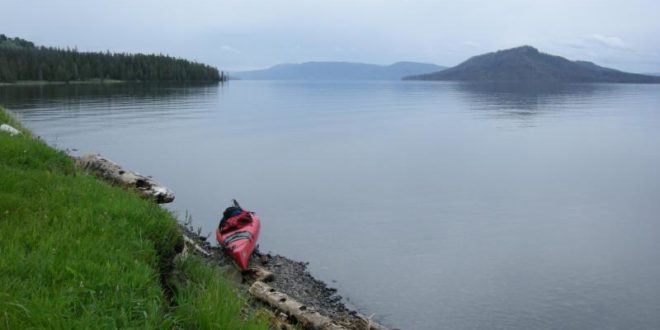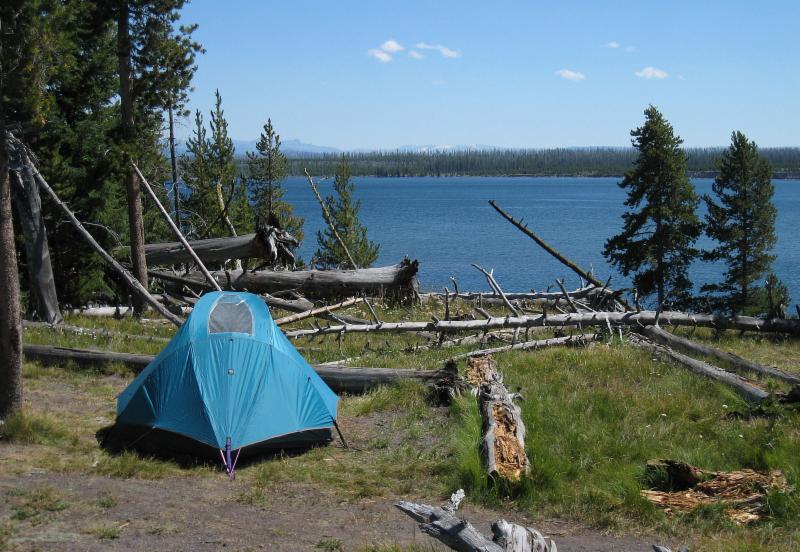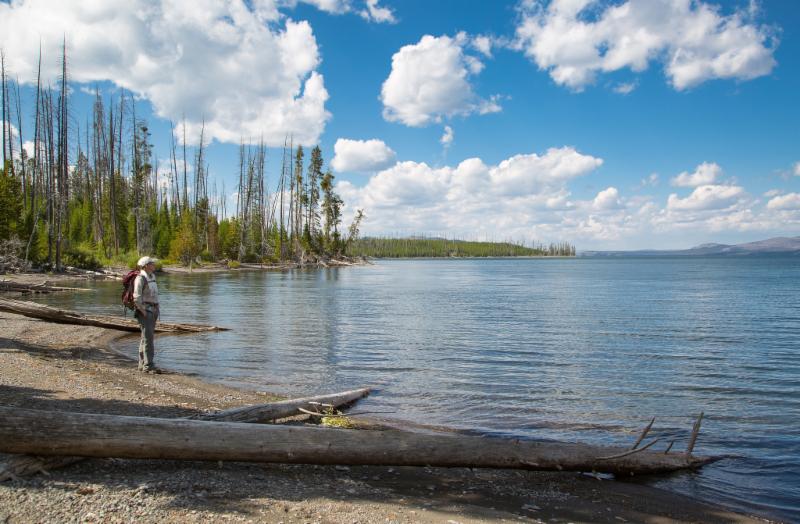Imagine kayaking on Yellowstone Lake, exploring the remotest reaches of the lake, far from civilization.
Montanans Parke Goodman, Lisa Kemmerer and Scott Hoeninghausen made that exact trip recently in Yellowstone National Park.
The five-night, six-day trip was put together by Hoeninghausen, a longtime Gardiner resident. Hoeninghausen said he got into kayaking about 16 years ago and has made dozens of kayaking-camping trips on Yellowstone Lake.
They set off from Pumice Point, which is located on the park’s Grand Loop Road between Grant Village and Fishing Bridge. Pumice Point is on the narrowest point of the West Thumb bay. From there, they paddled across an expanse of open water that took them to the lake’s southern shores. They stuck close to shore as they paddled to their first campsite, not far from another bay on the lake, the Flat Mountain Arm.
They had a couple of open water stretches to paddle across, but they were careful to do so early in the morning. Often in the afternoons, thunderstorm clouds and high winds kicked up, making the lake surface choppy. Kemmerer said the longest open water paddle took about half an hour.
Yellowstone Lake sits at nearly 8,000 feet in elevation. Its waters are iced over most of the year, giving it an average year-round temperature of 40 degrees.
“You’ve got about 25 minutes if you fall in,” Goodman said, referring to risk of dying from hypothermia.
They had time to explore both the South and Southeast Arms of Yellowstone Lake, remote bays where motorized boats are required to adhere to a “no-wake” rule, and the furthest reaches of the bays allow only non-motorized boats.
The trio paddled to a lakeshore backcountry campsite on Flat Mountain Arm, where they spend two nights. They hiked around during the day, spying bear and wolf tracks.
Fortunately, they never saw a wolf or a bear, but there were a lot of birds, including pelicans and bald eagles, along with deer.
On their third and fourth nights, they camped on the Southeast Arm of the lake, spending two nights there also. Goodman said he’d like to go back again and do more exploring up the Yellowstone River.
Their last night was on the eastern shore of the lake. They had time to do a little hiking on the Thorofare trail before they wrapped up their trip at Sedge Bay, where they had dropped off a car before starting the trip.
They saw only one other group of people in their five days, Goodman said.
But one “group” they saw plenty of was mosquitoes. Their campsites were all mostly right on the shore, which provided a bit of a breeze to help keep the bloodsuckers at bay. Hoeninghausen said the mosquitoes aren’t so bad earlier in June or later in the summer. Kemmerer, who has kayaked in Alaska and the Arctic, said those mosquitoes are “helicopter-like,” which made the Yellowstone bugs seem pretty tame in comparison. Goodman carried the well-known “Off!” brand of mosquito repellant and said it did a pretty good job.
They also carried bear spray—even on the water.
Camp food
Goodman, Kemmerer and Hoeninghausen all adhere to a vegan diet. People go vegan for a variety of reasons, some purely out of health concerns, others out of concern for the environmental impact of meat production, and others choose veganism so as not to contribute to the suffering of other sentient beings.
So without hot dogs and cheese, what kind of foods do vegans take camping?
Goodman said the three of them carried the whole gamut of vegan foods, from prepared boxed foods like hummus and chili, to nuts and seeds and on down to vegan junk food, including Oreo cookies, Twizzlers, and Pringles potato chips.
“There’s a lot of junk food that’s accidentally vegan,” Goodman’s wife, Bonnie, quipped after the trip.
Hoeninghausen, who brought the Pringles, said they’re great for camping because they remain uncrushed in the iconic Pringles can.
Kemmerer packed expedition foods like nuts and seeds, dried fruits including banana chips she dried herself and dried plums from Goodman’s plum trees outside his Livingston home. She also brought oatmeal and powdered soy or rice milk. She said she does well on a combination of couscous, potato flakes and soup packets for an evening meal.
Goodman packed food like Fantastic Food’s instant hummus and vegan chili mix, along with rice milk powder, apples and oranges, oatmeal and lots of fresh kale from his garden.
Hoeninghausen said he brought along some packaged, freeze-dried backpacking meals like rice and bean mixes. Some brands have several vegan options.
He also packed vegan hot dogs and tofu-based “turkey” for sandwiches. And he recommends angel hair pasta for any camping meal, vegan or not, because it cooks so quickly.
Kemmerer was thrilled with the all-vegan menu because she feels safer when she’s not camping with omnivores—who bring things like cheese and sausage—both of which have the potential to be a bear attractant.
“Their food puts me at risk,” she said.
And putting people at risk ultimately puts bears at risk, too, she said.
“When I go out there, I am conscious of the fact it is their world, not mine,” Kemmerer, who is an animal ethicist, said. “I never do anything that would threaten them or get them in trouble.”
Another bonus of vegan food is it doesn’t get rancid or go bad as quickly as meat or dairy products do.
Cleanup is easier, too, Kemmerer said. You don’t need to scrub or use a lot of soap.
If you go
To go kayaking on Yellowstone Lake, you’ll need a National Park Service boating permit, fishing permit (if you’re planning to fish) boat inspection (for aquatic invasive species), and if you’re planning to camp in the backcountry, backcountry campsite permits. The full list of regulations and information on acquiring a permit is available here.
Goodman said the campsites all had bear poles for hanging food, so take a lot of rope for slinging your food over the pole.
Bring appropriate technology to filter your water.
Don’t have a second car to leave at your put-out point? There’s a solution for that: Park concession company Xanterra Parks & Resorts offers a backcountry shuttle service boat ride. For not cheap but not prohibitively expensive, you can get a boat ride for you and your kayak or canoe into the more remote parts of the lake. You can even make plans to be picked up. You can read more about the program here.
You could also make friends with employees in the Lake Hotel area. Chances are good you could find someone who would help you shuttle a car the night before your trip. (Give them a generous tip—they might be working in paradise, but they’re not making a ton of money.)
A rudder for your kayak would be a good idea, too, to help steer in the rougher water, Goodman said. He also highly recommended a spray skirt to help keep you and your gear dry.
Goodman said one of the cool things about kayaking is that you can carry a lot more stuff—including food—than you can backpacking. He and Hoeninghausen even packed camp chairs. Sitting on the ground or a log gets old after a day of paddling or hiking, Hoeninghausen said.
And, as on any Yellowstone trip, have an assortment of clothing options available.
“Be prepared for any weather conditions,” Goodman said.
Hoeninghausen, too, is concerned about protecting bears. He urged anyone who camps in Yellowstone’s backcountry to carry bear spray in order to protect not only oneself, but to keep a bear out of the way of conflict with a human.
“Do everything you can do to avoid getting a bear in trouble,” Hoeninghausen said. “Carry bear spray and wash your dishes far away from your camp, so bears aren’t drawn to your campsite.”
 Yellowstone Insider Your Complete Guide to America's First National Park
Yellowstone Insider Your Complete Guide to America's First National Park








You must be logged in to post a comment.